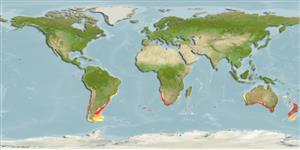Common names from other countries
分类 / Names
俗名 | 同种异名 | Catalog of Fishes(属, 种) | ITIS | CoL | WoRMS | Cloffa
Teleostei >
Scombriformes (Mackerels) >
Gempylidae (Snake mackerels)
Etymology: Thyrsites: Greek, thyrsites, -ou = stalk of a plant, an ornament like a pine cone borne by Bacchus (Ref. 45335).
Environment: milieu / climate zone / depth range / distribution range
生态学
海洋; 半咸淡水 底中水层性; 海洋洄游的; 深度上下限 0 - 550 m (Ref. 6390), usually 100 - 500 m (Ref. 6181). 亞熱帶的; 13°C - 18°C (Ref. 6181); 21°S - 56°S, 75°W - 177°E (Ref. 54924)
Southwest Atlantic: Uruguay, Argentina and Tierra del Fuego. Eastern Atlantic: Tristan da Cunha and South Africa. Western Indian Ocean: South Africa and the St. Paul and Amsterdam islands. Eastern Indian Ocean: Tasmania and southern coast of Australia. Southwest Pacific: New Zealand and southern coast of Australia. Southeast Pacific: southern Peru, Chile, and Tierra del Fuego.
西南大西洋: 烏拉圭,阿根廷與火地島。 東大西洋: 崔斯坦火山與南非。 西印度洋: 南非與聖保羅與阿姆斯特丹島。 東印度洋: 塔斯梅尼亞與澳洲的南部海岸。 西南太平洋: 紐西蘭與澳洲的南部海岸。 東南太平洋: 南方的祕魯,智利與火地島。
Length at first maturity / 大小 / 重量 / 年龄
Maturity: Lm 55.0, range 50 - 60 cm
Max length : 200 cm SL 雄鱼/尚未辨别雌雄; (Ref. 3630); common length : 75.0 cm SL 雄鱼/尚未辨别雌雄; (Ref. 6181); 最大体重: 6.0 kg (Ref. 6181); 最大年龄: 10 年 (Ref. 28892)
背棘 (总数): 19 - 21; 背的软条 (总数): 113; 臀棘 1; 臀鳍软条: 10 - 12; 脊椎骨: 35. Body elongate and strongly compressed. Lateral line single, running close to the upper contour of the body below most of the first dorsal-fin base then abruptly curving ventrally. Body is dark blue, slightly paler on belly; first dorsal fin membrane black (Ref. 6181).
细长的身体与非常扁长形的。 侧线然后突然地腹地弯曲,单独地,连续在大部分的第一背鳍基底之下接近身体的上面轮廓。 身体颜色较深蓝色, 些微较灰白在腹面上; 第一背鳍薄膜黑色.(参考文献 6181)
Inhabit continental shelves or around islands. Feed on pelagic crustaceans (Euphausia, Nyctiphanes), cephalopods and fishes (Ref. 6181) like anchovy and pilchard (Ref. 36731). Form schools near the bottom or midwater; sometimes even at the surface at night (Ref. 6181). Prefers temperature between 13° and 18°C (Ref. 36731). Marketed fresh, smoked, canned and frozen; eaten fried, broiled, microwaved and baked (Ref. 9988). Good for fish and chips or smoking; also made into fillet or fish cake in Japan (Ref. 6181). Commonly called as Baracoutta and because it is a fast predator, several English vessels were named after it. In the UK during WW II, this canned fish was commonly eaten that many older people have an aversion to it (D. Parkyn, pers. comm. 05/2022).
栖息于大陆架或岛的周围。 捕食大洋性的像 鱼与沙丁鱼的甲壳动物 ( Euphausia, Nyctiphanes) ,头足类动物与鱼 (参考文献 6181) 。 (参考文献 36731) 在底部或中层水域的附近形成鱼群; 有时甚至在水表面在晚上.(参考文献 6181) 偏爱在 13个 ° 与 18 °C 之间的温度。 (参考文献 36731) 在市场上销售生鲜、烟熏、罐装及冷冻; 油炸后食用, 火烤了, 微波了而且烧烤了。 (参考文献 9988) 对于鱼与薄片是好的或烟熏; 在日本也制成鱼排或鱼肉炸饼。 (参考文献 6181)
Life cycle and mating behavior
成熟度 | 繁殖 | 产卵场 | 卵 | 孕卵数 | 仔鱼
Spawning patterns are complex, with different stock spawning at different times of the year (Ref. 6390).西南大西洋: 烏拉圭,阿根廷與火地島。 東大西洋: 崔斯坦火山與南非。 西印度洋: 南非與聖保羅與阿姆斯特丹島。 東印度洋: 塔斯梅尼亞與澳洲的南部海岸。 西南太平洋: 紐西蘭與澳洲的南部海岸。 東南太平洋: 南方的祕魯,智利與火地島。
Nakamura, I. and N.V. Parin, 1993. FAO Species Catalogue. Vol. 15. Snake mackerels and cutlassfishes of the world (families Gempylidae and Trichiuridae). An annotated and illustrated catalogue of the snake mackerels, snoeks, escolars, gemfishes, sackfishes, domine, oilfish, cutlassfishes,. scabbardfishes, hairtails, and frostfishes known to date. FAO Fish. Synop. 125(15):136 p. (Ref. 6181)
CITES (Ref. 128078)
Not Evaluated
人类利用
渔业: 高经济性; 游钓鱼种: 是的
更多信息
合作者照片Stamps, Coins Misc.声音神经毒速度泳型鳃区Otoliths脑重体重比眼睛色素
工具
特别资料
下载 XML
网络资源
Estimates based on models
Preferred temperature (Ref.
115969): 6.2 - 16, mean 11.2 (based on 285 cells).
Phylogenetic diversity index (Ref.
82804): PD
50 = 1.0000 [Uniqueness, from 0.5 = low to 2.0 = high].
Bayesian length-weight: a=0.00427 (0.00237 - 0.00767), b=3.07 (2.90 - 3.24), in cm Total Length, based on LWR estimates for this species & (Sub)family-body (Ref.
93245).
营养阶层 (Ref.
69278): 3.6 ±0.3 se; based on diet studies.
回复力 (Ref.
120179): 中等的, 族群倍增时间最少 1.4 - 4.4年 (tm=2-4; tmax=10).
Prior r = 0.53, 95% CL = 0.35 - 0.80, Based on 3 stock assessments.
Fishing Vulnerability (Ref.
59153): Moderate to high vulnerability (53 of 100).
Climate Vulnerability (Ref.
125649): Moderate vulnerability (43 of 100).
